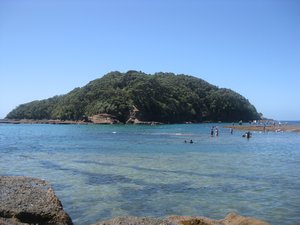Advertisement
Published: March 4th 2010

 NZ1 097
NZ1 097
Goat Island Marine ReserveWe are having a great time in New Zealand's remote Northland region, an area that most tourists ignore as they happily skip off to Queenstown or Rotorua.
What can we tell you about Northland (including the extremely remote "Far North")? Well, since it is subtropical, we thought it might be covered in lush rainforest, but it really isn't. Much of the native forest was logged years ago and so today, while there are some forests and many lovely beaches, Northland is mostly bucolic farmland with numerous pens with sheep, cows and deer. Interestingly, in New Zealand Bambi is considered a pest and is not only actively hunted but also actively farmed - venison appears on many menus here and is sold to neighboring countries.
Maybe the best way to understand this area is through the signs we've seen in our travels in the last few days:
- "Ice and bait" (on offer at every tiny, dusty convenience store)
- "Fresh oysters"
- "Call #501 to report wandering livestock"
- "Private collection of dinosaurs for viewing - 5km"
"Northland" pretty much covers everything north of Auckland. Despite being only four to six hours' drive from New Zealand's biggest city,

 NZ1 102
NZ1 102
Looking at snapper and other fish at the Goat Island Marine Reservethe towns and superb beaches north of the Bay of Plenty receive few visitors. January is peak tourist season (for both overseas travelers and Kiwis on summer holiday) and yet we've seen relatively few cars on the roads and have greedily enjoyed several pristine white sand beaches - almost all to ourselves. This area really is a hidden gem.
We considered a few different stops in this semi-tropical "Winterless North":
- The West Coast of Northland, which runs along the Tasman Sea, is very rarely visited by tourists. It is home to small Maori communities and is known primarily for the Waipoua Kauri Forest. Kauris are among the most ancient trees in the world, growing as tall as 150 feet and boasting enormous trunks (as big as 25 feet around - in league with California's giant sequoias - just try to hug that!). The Maoris are especially fond of kauris and have used them for centuries to make their extremely important haka (canoes). Unfortunately, when the Europeans arrived, logging began and, sadly, few of these gentle giants are left in New Zealand today. So it is a real thrill to be able to see kauris up close.
- The East Coast (on the Pacific Ocean) consists of a long string of harbors, bays, pretty beaches and one particularly great diving spot (Poor Knights Islands). The beaches closest to Auckland are prime vacation home territory but go a bit further north and you'll find tiny towns of locals who revel in their privacy and off-the-map existence.
-The VERY FAR NORTH also sounded cool. At the top of the North Island on a long thin peninsula are Ninety Mile Beach and Cape Reinga.
We'd love to cover all 14,000 square kilometers of Northland (just slightly smaller than the state of Connecticut - but with a population of only 150,000 vs. 3.5 million for our friends in CT) but we only have about a week before we need to migrate south. So our general plan is to base ourselves for about four days in the cute little East Coast beach-bum town of Paihia to explore the exquisite Bay of Islands and perhaps go as far as Cape Reinga if we can work it out.
And, no, unfortunately we didn't have time to stop to see the dinosaur collection. We're still wondering about that . . .
Advertisement
Tot: 0.084s; Tpl: 0.011s; cc: 10; qc: 24; dbt: 0.0606s; 1; m:domysql w:travelblog (10.17.0.13); sld: 1;
; mem: 1mb

 NZ1 097
NZ1 097
 NZ1 102
NZ1 102
